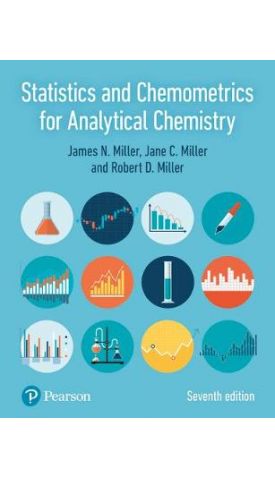אנו משתמשים ב-Cookies כדי לשפר את החוויה שלך. כדי לקיים ההנחיה החדשה של e-Privacy, עלינו לבקש את הסכמתך להגדיר את ה-Cookies. קבלת מידע נוסף.
428.00 ₪
Statistics and Chemometrics for Analytical Chemistry
428.00 ₪
ISBN13
9781292186719
יצא לאור ב
Harlow
מהדורה
7th New edition
עמודים / Pages
IE
פורמט
Paperback / softback
תאריך יציאה לאור
16 באפר׳ 2018
מחליף את פריט
9780273730422
Statistics and Chemometrics for Analytical Chemistry 7th edition provides a clear, accessible introduction to main statistical methods used in modern analytical laboratories.
It continues to be the ideal companion for students in Chemistry and related fields keen to build their understanding of how to conduct high quality analyses in areas such as the safety of food, water and medicines, environmental monitoring, and chemical manufacturing. With a focus on the underlying statistical ideas, this book incorporates useful real world examples, step by step explanation and helpful exercises throughout.
Features of the new edition:
* Significant revision of the Quality of analytical measurements chapter to incorporate more detailed coverage of the estimation of measurement uncertainty and the validation of analytical methods.
* Updated coverage of a range of topics including robust statistics, Bayesian methods, and testing for normality of distribution, plus expanded material on regression and calibration methods.
* Additional experimental design methods, including the increasingly popular optimal designs.
* Worked examples have been updated throughout to ensure compatibility with the latest versions of Excel and Minitab.
* Exercises are available at the end of each chapter to allow student to check understanding and prepare for exams. Answers are provided at the back of the book for handy reference.
This book is aimed at undergraduate and graduate courses in Analytical Chemistry and related topics. It will also be a valuable resource for researchers and chemists working in analytical chemistry.
| מהדורה | 7th New edition |
|---|---|
| עמודים / Pages | IE |
| מחליף את פריט | 9780273730422 |
| פורמט | Paperback / softback |
| ISBN10 | 1292186712 |
| יצא לאור ב | Harlow |
| תאריך יציאה לאור | 16 באפר׳ 2018 |
| תוכן עניינים | Preface to the seventh edition Preface to the first edition Acknowledgements Glossary of symbols 1 Introduction 1.1 Analytical problems 1.2 Errors in quantitative analysis 1.3 Types of error 1.4 Random and systematic errors in titrimetric analysis 1.5 Handling systematic errors 1.6 Planning and design of experiments 1.7 Statistical calculations Bibliography and resources Exercises 2 Statistics of repeated measurements 2.1 Mean and standard deviation 2.2 The distribution of repeated measurements 2.3 Log-normal distribution 2.4 Definition of a 'sample' 2.5 The sampling distribution of the mean 2.6 Confidence limits of the mean for large samples 2.7 Confidence limits of the mean for small samples 2.8 Presentation of results 2.9 Other uses of confidence limits 2.10 Confidence limits of the geometric mean for a log-normal distribution 2.11 Propagation of random errors 2.12 Propagation of systematic errors Bibliography Exercises 3 Significance tests 3.1 Introduction 3.2 Comparison of an experimental mean with a known value 3.3 Comparison of two experimental means 3.4 Paired t-test 3.5 One-sided and two-sided tests 3.6 F-test for the comparison of standard deviations 3.7 Outliers 3.8 Analysis of variance 3.9 Comparison of several means 3.10 The arithmetic of ANOVA calculations 3.11 The chi-squared test 3.12 Testing for normality of distribution 3.13 Conclusions from significance tests 3.14 Bayesian statistics Bibliography Exercises 4 The quality of analytical measurements 4.1 Introduction 4.2 Sampling 4.3 Separation and estimation of variances using ANOVA 4.4 Sampling strategy 4.5 Introduction to quality control methods 4.6 Shewhart charts for mean values 4.7 Shewhart charts for ranges 4.8 Establishing the process capability 4.9 Average run length: CUSUM charts 4.10 Zone control charts (J-charts) 4.11 Proficiency testing schemes 4.12 Method performance studies (collaborative trials) 4.13 Uncertainty 4.14 Acceptance sampling 4.15 Method validation Bibliography Exercises 5 Calibration methods in instrumental analysis: Regression and correlation 5.1 Introduction: instrumental analysis 5.2 Calibration graphs in instrumental analysis 5.3 The product-moment correlation coefficient 5.4 The line of regression of y on x 5.5 Errors in the slope and intercept of the regression line 5.6 Calculation of a concentration and its random error 5.7 Limits of detection 5.8 The method of standard additions 5.9 Use of regression lines for comparing analytical methods 5.10 Weighted regression lines 5.11 Intersection of two straight lines 5.12 ANOVA and regression calculations 5.13 Introduction to curvilinear regression methods 5.14 Curve fitting 5.15 Outliers in regression Bibliography Exercises 6 Non-parametric and robust methods 6.1 Introduction 6.2 The median: initial data analysis 6.3 The sign test 6.4 The Wald-Wolfowitz runs test 6.5 The Wilcoxon signed rank test 6.6 Simple tests for two independent samples 6.7 Non-parametric tests for more than two samples 6.8 Rank correlation 6.9 Non-parametric regression methods 6.10 Introduction to robust methods 6.11 Simple robust methods: trimming and winsorisation 6.12 Further robust estimates of location and spread 6.13 Robust ANOVA 6.14 Robust regression methods 6.15 Re-sampling statistics 6.16 Conclusion Bibliography and resources Exercises 7 Experimental design and optimisation 7.1 Introduction 7.2 Randomisation and blocking 7.3 Two-way ANOVA 7.4 Latin squares and other designs 7.5 Interactions 7.6 Identifying the important factors: factorial designs 7.7 Fractional factorial designs 7.8 Optimal experimental designs 7.9 Optimisation: basic principles and univariate methods 7.10 Optimisation using the alternating variable search method 7.11 The method of steepest ascent 7.12 Simplex optimisation 7.13 Simulated annealing Bibliography and resources Exercises 8 Multivariate analysis 8.1 Introduction 8.2 Initial analysis 8.3 Principal component analysis 8.4 Cluster analysis 8.5 Discriminant analysis 8.6 K-nearest neighbour (KNN) method 8.7 Disjoint class modelling 8.8 Regression methods 8.9 Multiple linear regression (MLR) 8.10 Principal components regression (PCR) 8.11 Partial least-squares (PLS) regression 8.12 Natural computation methods: artificial neural networks 8.13 Conclusion Bibliography and resources Exercises Solutions to exercises Appendix 1: Commonly used statistical significance tests Appendix 2: Statistical tables |


Login and Registration Form